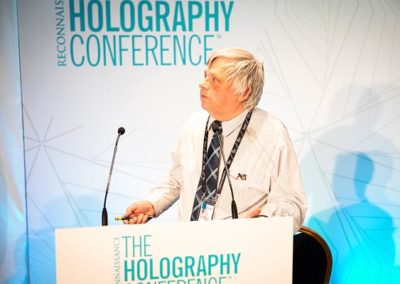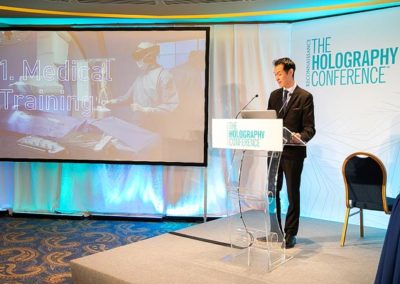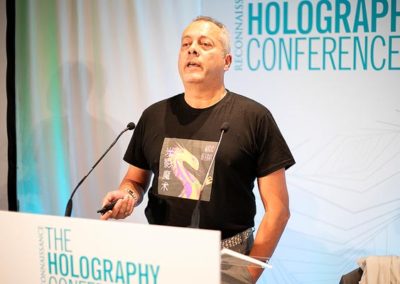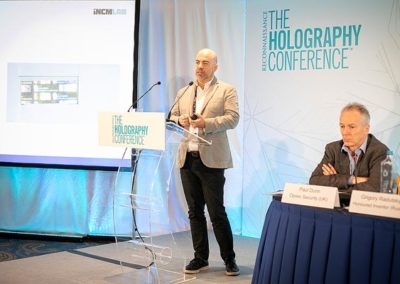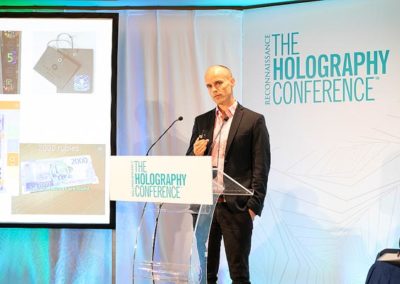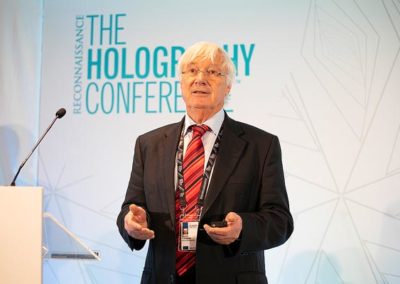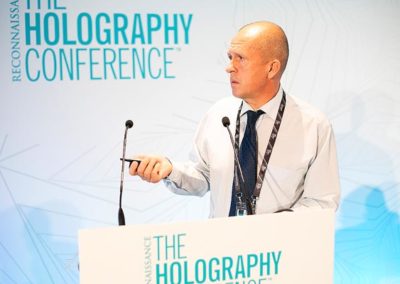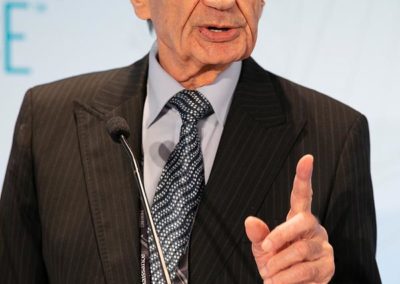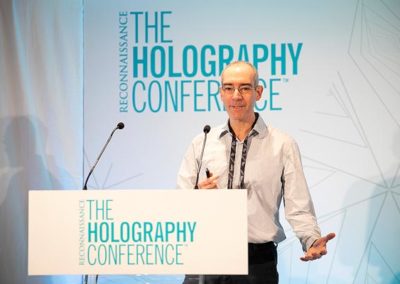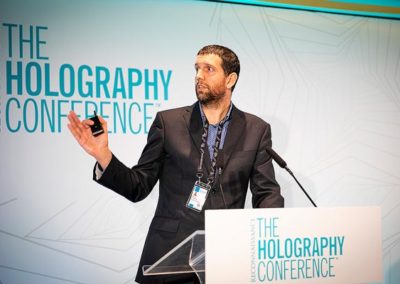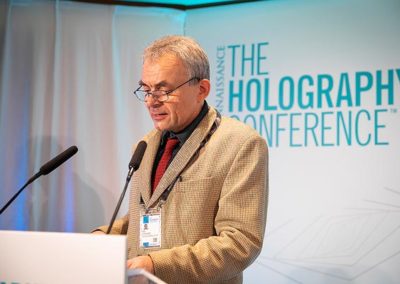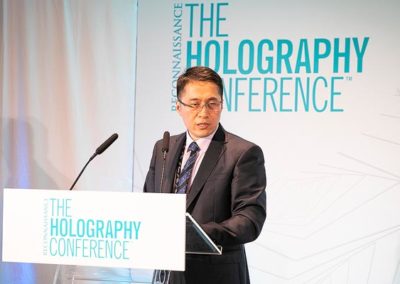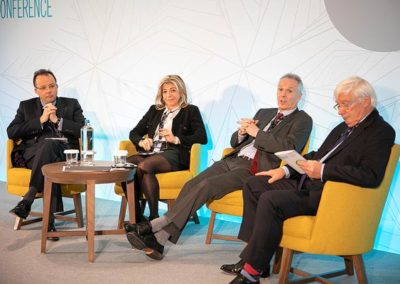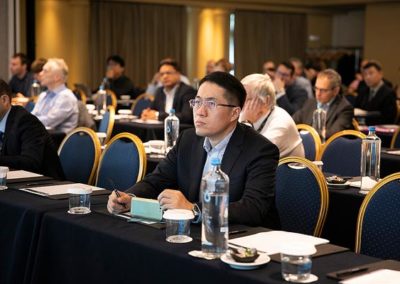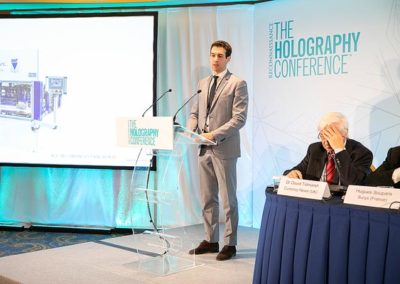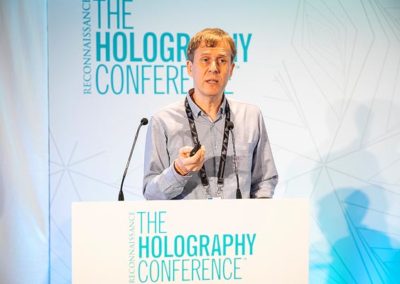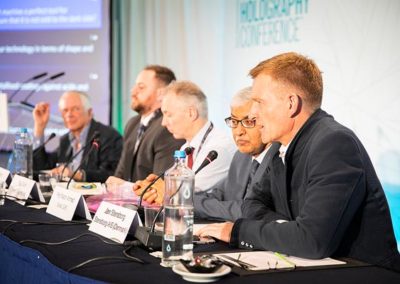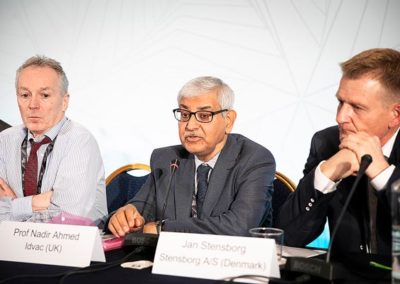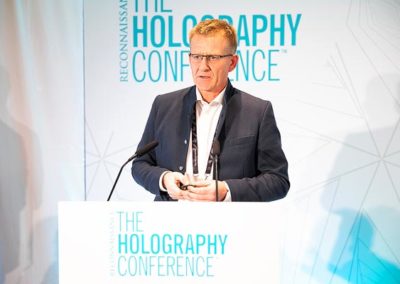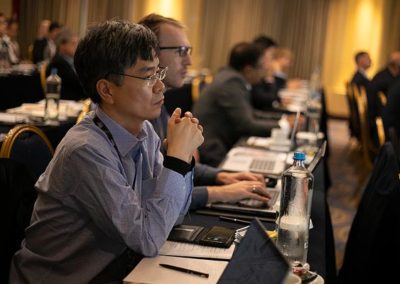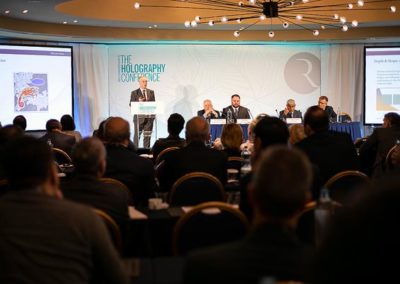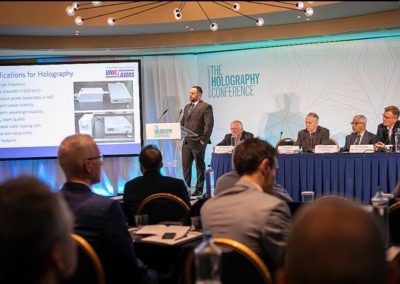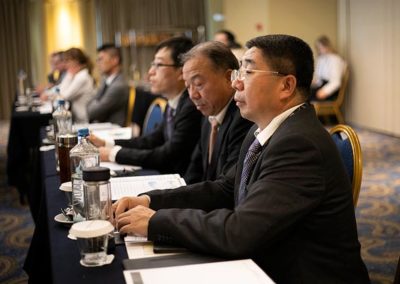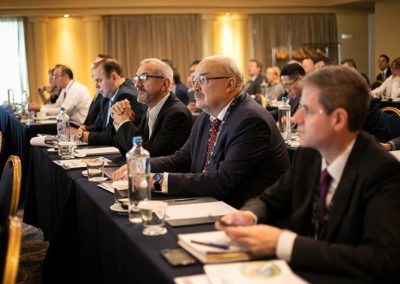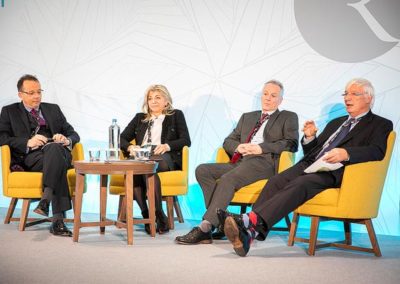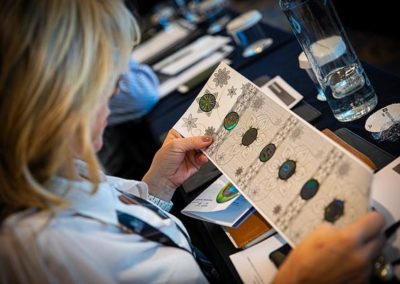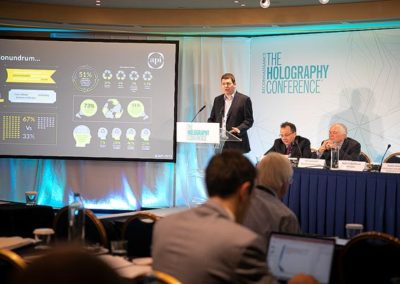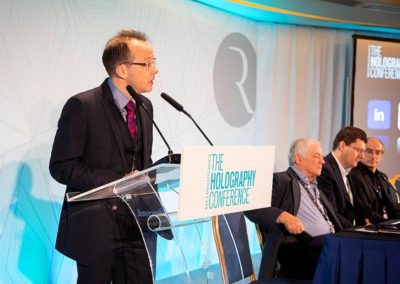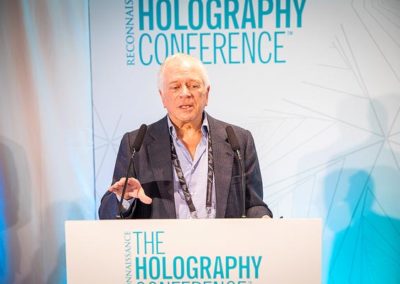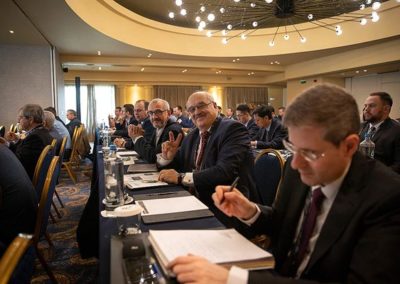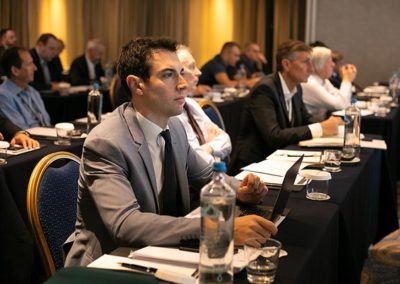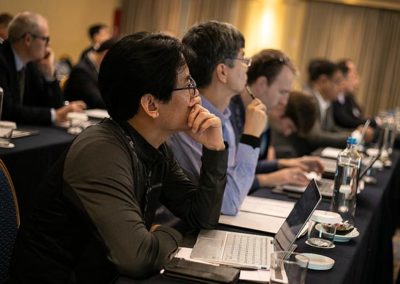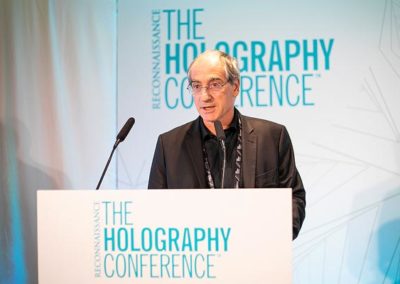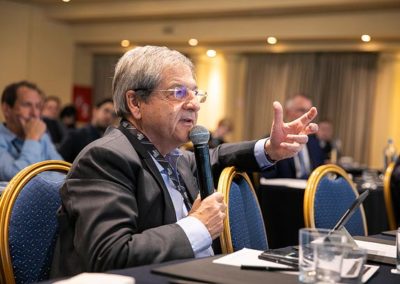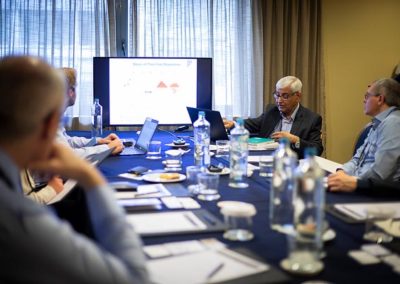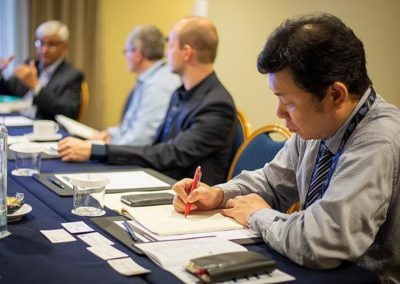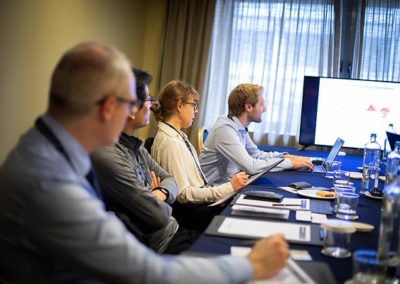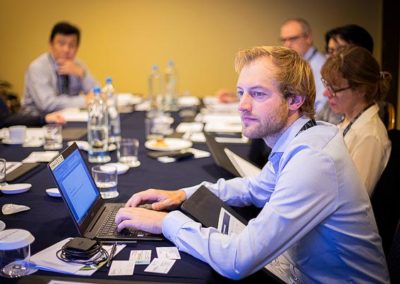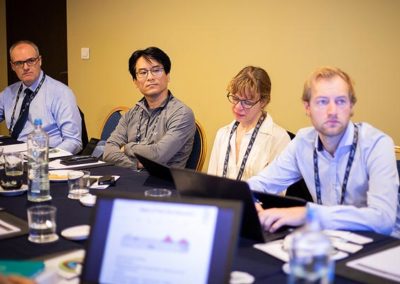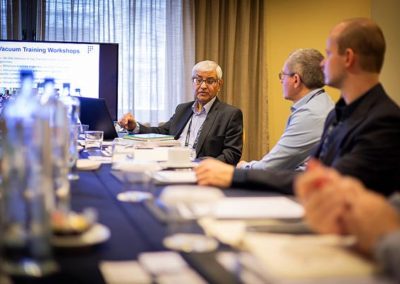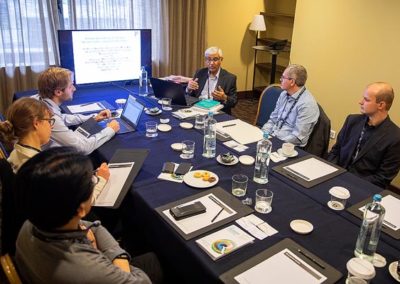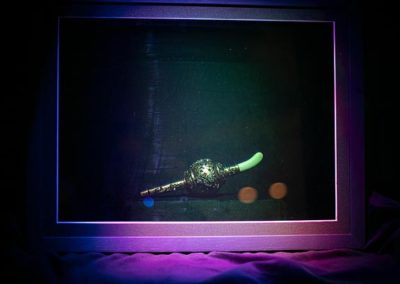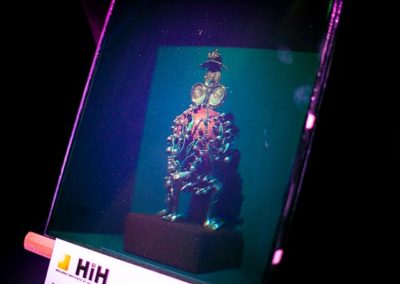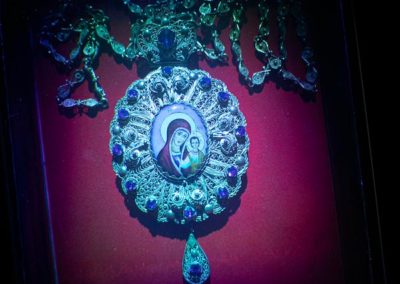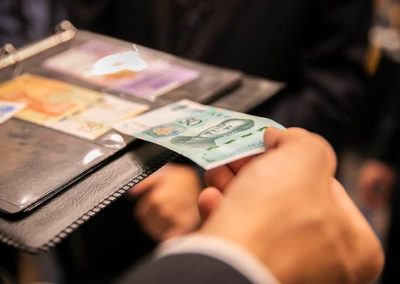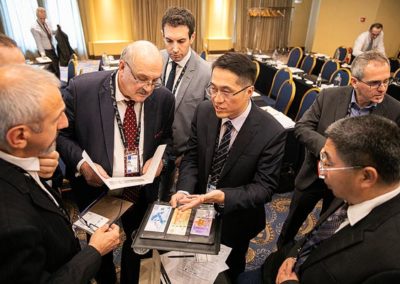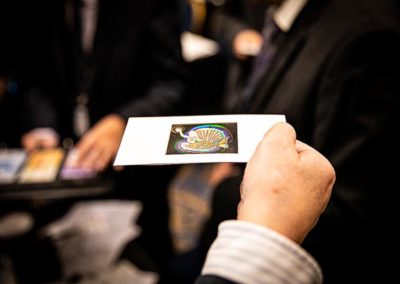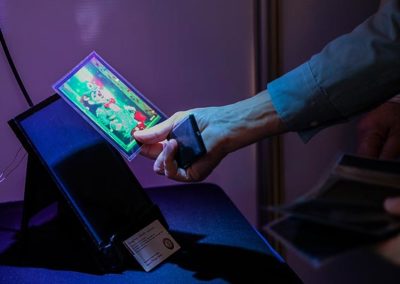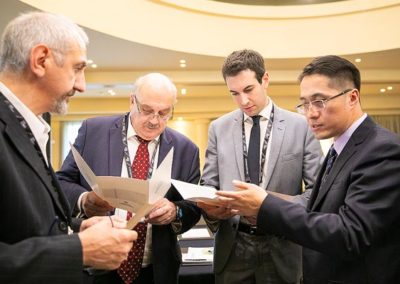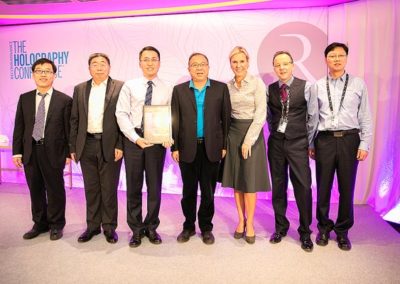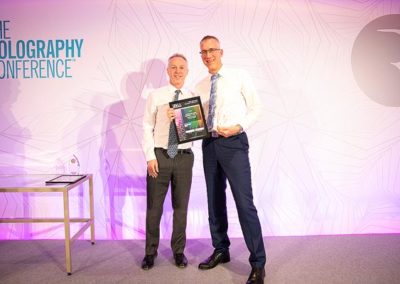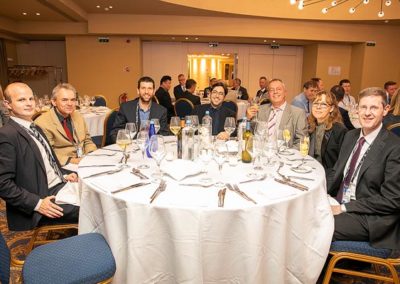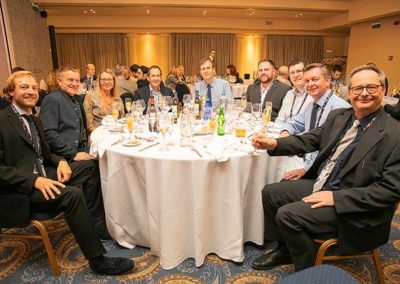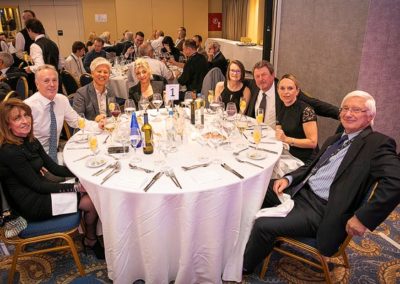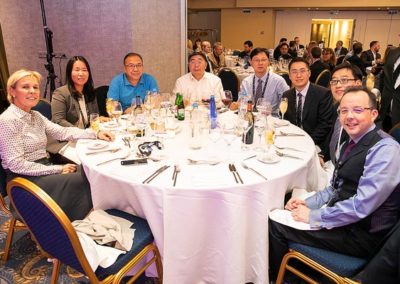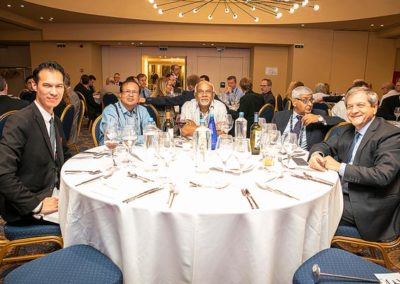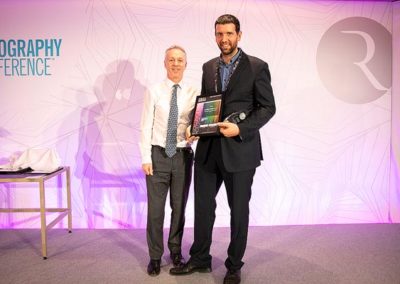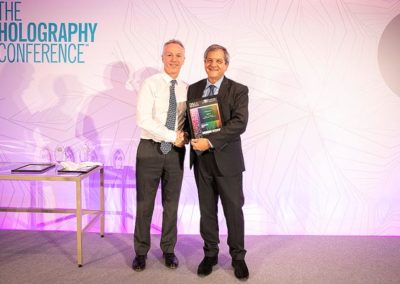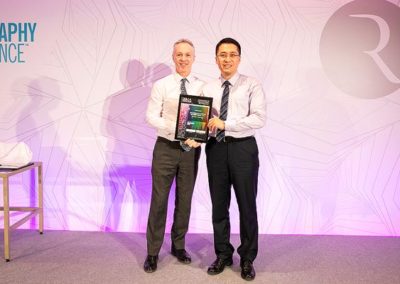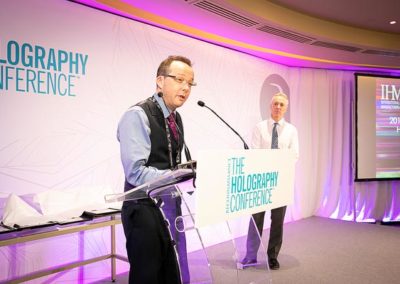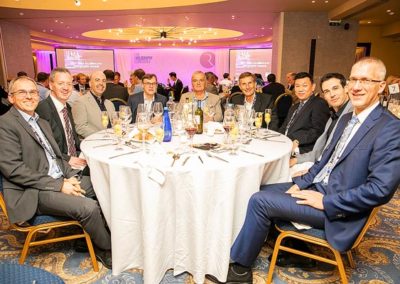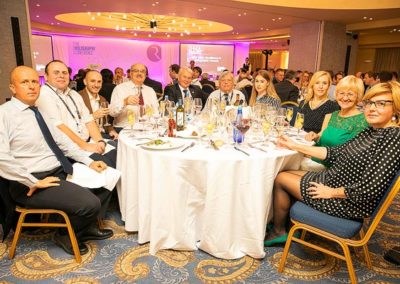Attendee's Geolocation
2019 Review
The Holography Conference Shows Diversity and the Latest Innovations
87 delegates from 55 organisations and 25 countries attended The Holography Conference™ in Athens, Greece on 14-15th November.
Holography, Packaging and Patent Trends
The Holography Conference was officially opened by Dr Mark Deakes, Conference Director and General Secretary of the IHMA. The first session included three papers. The first, titled ‘Human Senses & Holograms: Their Role in the Digital Age’ by Ian Lancaster from Reconnaissance International provided an excellent insight of the role in human senses in validating holograms and security documents which incorporate multiple levels of security that can be inspected. This was contrasted with the increasing digital world, using smartphones and devices, where we don’t question, we trust that the information is accurate and connection is secure to make payments, authenticate a product or prove identity.
This was followed by a presentation from Richard Burhouse on ‘How Standing Out Doesn’t Need to Cost the Earth’, which highlighted the great strides and pledges made by brands and governments in reducing the environmental impact of packaging. To meet this need API built on their compostable laminates credentials and produced an environmentally friendly and sustainable holographic and / or metallised ‘film free’ product called Transmet™ which has grown to become the genuine alternative to metallised polyester. Transmet which is classified as a ‘mono material’ has an extremely low metal content helping to ensure recyclability and repulpability of the finished carton board product.
Patents – Impact and Interest in the Holography Industry by André Honnorat from Honnorat Recherches & Services was the final presentation of this session which provided key information about patents. Key trends highlighted China as now the leadi


New Technology Applications of Holography
In the second session, Scott Early from UniK Lasers opened the session with a paper titled ‘High power red & other Single Frequency DPSS lasers as key instruments for Holography.’ The lasers use the patented BRaMMS (Bragg Range Michelson Mode Selector) technology to ensure long term wavelength stability. The latest Solo 640 laser has been designed for holography and includes integrated water cooling, graphical user interface options and laser head covers.
This was followed by a presentation by Dr Paul Dunn from Opsec and IHMA Chairman on ‘The Future for Holographic and Non-holographic OVD Solutions’ who outlined how holography is evolving and can offer a much greater degree of sophistication. However, it is now one of a growing array of security optical features that meets the multi-level security requirement of the current market.
The penultimate paper of the session was given by Prof Nadir Ahmed from Idvac titled ‘Vacuum Metallised Nano Black & Other Coatings with No Inks or Dyes.’ The paper outlined new innovative processes that can now add different colours such as white and black to plain and embossed films using a standard roll to roll metalliser without the need for dyes or inks.
The final paper of the session on Inkjet Metallising was given by Jan Stensborg who outlined a new process for cost effective partial, in-register, in-line print manufacturing of metallised nano and micro-structures. The new process utilises a thermally cured composite metal ink that is designed to form nanometre thin layers that conforms to micro / nanostructured surfaces.


Hologram Origination and Authentication
Session three began with presentations from IQ Structures, Computer Holography Centre, Police Presidium and Zhongchao Special Security Technology from China.
Jakub Svoboda from IQ Structures presented ‘The Keyhole Mystery: Sophisticated Diffractive Structures’ and outlined a multi-faceted diffractive security stripe feature that incorporates a range of features including a diffractive keyhole effect that displays ‘larger’ images behind small windows with a real 3D effect.
This was followed by Anton Goncharsky’s presentation from Computer Holography Centre on ‘Modern possibilities of electron-beam lithography for synthesis of computer generated holograms.’ A number of effects were outlined including full parallax DeColor, SmartGlint along with other benefits of electron beam technology.
The next presentation from Czech Police Presidium by Ivo Aubrecht focussed on the use of confocal microscopy, scatterometry and light spectrometry for the inspection of diffraction and interference-based optical devices for document security. The presentation concluded that confocal microscopy is the only optical technique that enables imaging of surface relief security devices that allows basic profile shapes to be determined.
The final presentation of the session was from Dr Kai Sun from Zhongchao Special Security Technology Co., Ltd (ZSST) who outlined the development of sub-wavelength diffractive security products based on plasmonics with the unveiling of a new diffractive feature called ColorTrace™.
The Future of Holography (Panel Discussion)
The final session of day one finished with a panel discussion on The Future of Holography. Panellists included: Dr’s David Tidmarsh and Paul Dunn from Reconnaissance International and Opsec, and Corinne Murcia from Surys. The panel took questions and comments from the delegates and concluded that whilst there are some opportunities for holography outside of the packaging and security sectors such as for solar arrays etc… the industry is also facing the increasing threat from digitisation for payments, ID and product authentication, dematerialisation of security documents and increased environmental and sustainability concerns in the packaging market. However, the industry has continued to innovate with the evolution of new products to keep holography contemporary and fit for the modern day.
The first day full day of the conference concluded with conference dinner during which the IHMA Awards for Excellence in Holography were announcement and presented (see page).

Applications of Holography for Security (parts a and b)
The first paper of day two was presented by Surys founder and president Hugues Souparis on ‘Surface Plasmons – A new Paradigm for DOVID’s.’ Hugues gave a fascinating overview of the evolution of first order diffractive devices from the micro to nano scale prior to outlining the latest plasmonic devices (Plasmogram™ Reverso) that are now industrialised and available for the high security document market such as banknotes.
The second presentation of the session from Diavy’s Alessio Pastorelli outlined the company’s holographic equipment portfolio and their new CDM-R demetallisation machine. This was followed Philippe Gentet’s presentation from Kwangwoon University on a ‘Chimera™ – The New Holographic Solution for Security Applications.’ The paper described the new holoprinter technology, that is now possible to achieve the improbable combination of: low-power, low-cost continuous wave lasers (20 mW) and fast printing.
The last paper of the session was presented by Professor Jacob (Koby) Scheuer from Tel-Aviv University on ‘Holographic anti-counterfeiting tags utilising speckle pattern “fingerprint”: NanoSpeck tags.’ The presentation outlined how holographic metasurfaces incorporating nano-structures are utilised to produce a tag that projects an ‘un-clonable’ speckle pattern (fingerprint) that can be read by a smartphone for authentication.
Part b of the session included five papers on a range of topics beginning with Russian honoured inventor Grigory Radutsky who presented a paper titled ‘Instant Holography – a Single Copy in Seconds’. The paper outlined the development of a new sheet material that contains two parallel metallised diffraction grids and a metallised foil. An instant hologram is then produced when the material interacts with laser pulses.
Demax Holograms presented their latest innovation with a paper titled ‘Security Nano Optical Device for Visual Recognition and Smartphone Verification’. The paper outlined some of the latest features developed using electron beam including a diffractive black structure and the new E-LIDOGRAM Smartcode, which is authenticated using a smartphone and can be used for both labels and hot stamp foiling products.
An update on diffractive foil features on banknote was then provided by Dr David Tidmarsh from Reconnaissance International who outlined the recent trends in hologram usage for banknotes and what competing technologies are now available. This was followed by the penultimate paper of the session by Jan Thiele from Prismade who presented a paper on smart holograms for smartphone based verification. The paper outlined how the latest smart hologram is more secure than camera based systems, does not require the need for additional devices and knowledge about hologram features. Authentication is touch activated and can also work offline.
The final paper of the session was presented by Nuno Gonçalves, from the Portuguese Mint and Official Printing Office, on the ‘Validation of Holograms in the Hands of the Consumer’. The paper outlined the UNIQODE® feature, that utilises random-generated geometric coordinates of a hologram that can be used as a fingerprint and authenticated using a smartphone

The Future & Past: Display Holograms and Augmented Reality
The final session of the conference was dedicated to display holography and included three papers. The first paper was from Alkis Lembessis’ Hellenic Institute of Holography on ‘Images of Light™ Magic, Art & Science’ and showcased how display holography can be used as an intermediate for science communication. The paper provided an insight to The Magic of Light display holography exhibitions and exhibits with an overview of the latest exhibition in Shanghai earlier this year. The Shanghai exhibition attracted 440,000 visitors which for now is likely to be a world record for the exposure of display holograms in an exhibition.
The second and penultimate paper titled ‘Augmenting the World of Work – The Latest Developments in AR’ from Richard Lewington outlined how holographic AR based devices such as HoloLens are changing the world of work in retail, maintenance, medicine, entertainment, tourism and many other areas.
The final paper of the conference was presented by Prof Hans Bjelkhagen Hans provided a fascinating overview of ‘Interesting & Rare Commercial Display Holograms’ which included an historic look at the first commercial display holograms up to the latest OptoClones™.
Hellenic Institute of Holography
Crown Roll Leaf
The State Forensic Examination Committee of the Republic of Belarus
Gallery
Click on any picture to see the full gallery.
CBPM
University of Cambridge
De Montfont University
Attendees
API Group
USA
Banco de España
Spain
Bank Al-Maghrib
Morocco
Bauman Moscow State Technical University
Russia
CJSC Holography Industry Ltd
Belarus
Crown Roll Leaf Inc
USA
CSEM SA Basel
Switzerland
Czech Technical University in Prague
Czech Republic
Danmarks Nationalbank
Denmark
Dar As-Sikkah
Morocco
DEMAX Holograms Plc
Bulgaria
Deutsche Bundesbank
Germany
Diavy Srl
Italy
DNP Imagingcomm Europe B.V.
Netherlands
Eluceda
United Kingdom
ETRI
South Korea
Fabriano SpA
Italy
Federal State Unitary Enterprise (STC Atlas)
Russia
Formas Inteligentes S.A. De C.V.
Mexico
Hansholo Consulting Ltd
Sweden
Hellenic Institute of Holography
Greece
Hologram Company RAKO GmbH
Germany
Hologram Industries Research GmbH
Germany
HoloGrate JSC
Russia
Honnorat Recherches & Services
France
IDvac Ltd
United Kingdom
Internal Security Agency
Poland
International Hologram Manufacturers Association
United Kingdom
IQ Structures
Czech Republic
ITW Imagedata
United Kingdom
JSC RPC Krypten
Russia
Kwangwoon University
South Korea
Mitsubishi Polyester Film GmbH
Germany
MTM Holografi Guvenlikli Basim Ve Bilisim Teknolojileri San.ve Tic. A.S
Turkey
O-TEC Ltd
Japan
OpSec Security Group
United Kingdom
OST
Russia
OVD Kinegram AG
Switzerland
P.N. Lebedev Institute of Physics, Russian Academy of Sciences
Russia
Papierfabrik Louisenthal GmbH
Germany
Police Presidium CR
Czech Republic
Polish Holographic Systems s.c.
Poland
Portuguese Mint – Imprensa Nacional Casa da Moeda SA
Portugal
Prismade Labs GmbH
Germany
Process Color
India
Productos Dorel S.A. de C.V.
Mexico
PT Jasuindo Tiga Perkasa Tbk
Indonesia
Richard Lewington
Spain
Stensborg A/S
Denmark
SURYS
France
Tel Aviv University
Israel
Toppan Europe GmbH
Germany
UFLEX Ltd (Holography Division)
India
Unik Lasers
United Kingdom
Zhongchao Special Security Technology Co Ltd
China
Programme
Thursday 14 November
Hover on the presentation title or speaker to see if more information is available.
Presentation is available for download, click on the icon to access the download page.
Session 1: Holography, Packaging and Patent Trends
09:05
Human Senses & Holograms: Their Role in the Digital Age
Ian Lancaster
Reconnaissance International (UK)
Session 2: New Technology Applications for Holography
10:45
High power red and other Single Frequency DPSS lasers as key instruments for holography
Scott Early
Unik Lasers (UK)
Session 3: Hologram Origination, Authentication and Machinery
13:15
The Keyhole Mystery: sophisticated diffraction structures
Jakub Svoboda
IQ Structures (Czech Republic)
13:35
Modern possibilities of electron-beam lithography for synthesis of computer generated holograms
Anton Goncharsky
Computer Holography Centre (Russia)
13:55
Employment of confocal microscopy, scatterometry & light spectrometry in inspection of diffraction and interference based optical devices for document security
Ivo Aubrecht
Police Presidium (Czech Republic)
14:15
CDM-R machine, a turnkey solution for demetallization process by Diavy srl.
Alessio Pastorelli
DIAVY Srl (Italy)
Session 4: The Future of Holography
15:05 – Panel Discussion
Friday 15 November
Session 5: Applications of Holography for Security
09:20
Sub-wavelength diffractive security products with stable colors and appealing kinetic features
Kai Sun
Zhongchao Special Security Technology (China)
09:40
Chimera Security – The New Holographic Solution for Security Applications
Philippe Gentet
Kwangwoon University (South Korea)
10:00
Authenticating the Authenticator – The Nano Speck Security Hologram
Prof. Jacob (Koby) Scheuer
Tel-Aviv University (Israel)
Session 6: Applications of Holography for Security
11:20
Security Nano Optical Device for Visual Recognition and Smartphone Verification
Valentin Monovski
Demax (Bulgaria)
12:00
Smart Hologram – Electronic Holograms for Smartphone based Verification
Jan Thiele
Prismade GmbH (Germany)
12:20
The validation of hologram in the hands of the consumer
Nuno Gonçalves
Portuguese Mint and Official Printing Office (Portugal)
Session 7: Display Holography: Past, Present & Future
14:05
Augmenting the world of work-The Latest Developments in AR
Richard Lewington
Cambridge Assessment (UK)
Awards
The 2019 awards see Surys flying high after scooping the coveted ‘Innovation in Holographic Technology’ award for its new generation Montgolfier optical security feature for windowed banknote documents. Incorporating plasmonic sciences and nano-technologies, the highly effective solution includes Plasmogram Reverso technology to provide superior levels of product authentication and veracity.
Other award winners were:
- ‘Best Applied Security Product’ – Leonhard Kurz’s KINEGRAM COLORS with FLUX Effect
- ‘Best Applied Decorative/Packaging Product – PT Pura Barutama’s Force Magic Holographic Shrink Sleeve
- ‘Best Display or Emerging Technology Application of Holography’ – Holography Forum’s dynamic holographic display, The Fantatrope
- ‘Best Origination’ – IQ Structures’ Holographic Bank Note Stripe – Euro
Award ceremony photos are available in the gallery above.
Sponsors
Thank you to our 2019 Sponsors and Exhibitors
Many thanks to the following sponsors and exhibitors for taking part in our wonderful exhibition running alongside the conference:
Gold – China Banknote Printing and Minting Corporation – ZSST
Honorary – IHMA, Hellenic Institute of Holography


